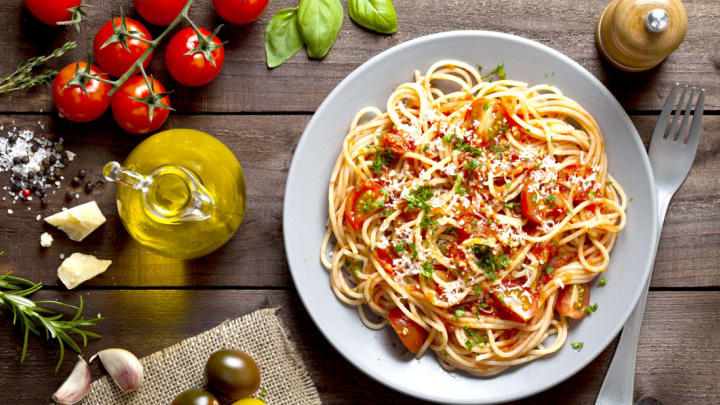The word calorie carries a lot of weight. We know we're supposed to avoid too many of them, but things get more complicated after that. What, exactly, are calories, and how do I burn them?
THE SCIENCE OF THE CALORIE
A calorie is a unit of heat energy that fuels your body, making it possible to move, breathe, think, sleep—and even digest food to make more energy.
While there is some disagreement about who first coined the term calorie, we know the French chemist Antoine Lavoisier used it in experiments he conducted during the winter of 1782–1783. He used a device called a calorimeter to measure how much ice melted in a metal container due to the heat emitted by guinea pigs housed inside it. Over time, that measurement was refined by other scientists to mean the amount of energy needed to raise the temperature of a kilogram of water by 1°C—what's known as a kilocalorie.
The food calorie and a kilocalorie (kcal) are technically the same thing, but we use the term calorie rather than kilocalorie because of an American chemist named Wilbur Olin Atwater. In the late 1880s, Atwater traveled to Germany to study at physiologist Carl Voit's laboratory, where Voit was researching the nutritional value of food and animal feed. Inspired by that research, Atwater took measurements of different foods with a bomb calorimeter—a device that essentially measures the heat in food when burned—by having study participants eat, and then measuring and subtracting [PDF] the amount of heat leaving their bodies through respiration and waste. He used a respiration calorimeter to measure their breath and a bomb calorimeter to burn their poop, and from that calculated just how many calories were left in their bodies to be used. When writing about his research, Atwater used the word calorie (kcal wouldn't be used in America until 1894, when it was published in a physiology textbook).
Based on his experiments, Atwater created a system for calculating the calories that human bodies can get from our food. There are three types of food nutrients that deliver caloric energy—fats, proteins, and carbohydrates—and Atwater arrived at a caloric measurement of each: A fat gram has nine calories, while a gram of protein and a gram of carbohydrates each have four. That system was modified [PDF] by USDA scientists in 1973, but it's otherwise still the basis for how calories are calculated today.
WHAT HAPPENS TO A CALORIE IN YOUR BODY
When you eat, enzymes in the mouth, stomach, and intestine break down nutrients by turning fats into fatty acids, sugars into simple sugars, and proteins into amino acids. Then, using oxygen cells throughout your body, these components are broken down into energy—a process known as metabolism.
Most of the calories we burn each and every day are used just to keep our body functioning, with about half going toward powering our major organs—the brain, liver, kidneys, and heart. We use the rest for physical activity and the process of converting food to energy. Anything not used by the body is then stored, first in the liver and eventually as fat cells.
Some foods, like honey (carbohydrates), are easily digestible, whereas nuts (a mix of carbohydrates, fat, and protein) can't actually be fully digested at all. There are also digestibility differences within the same type of food. For example, in plants, older leaves tend to be sturdier (and therefore harder to digest) and less caloric than younger ones. Most significantly, especially in terms of human evolution, whenever we cook or process food, the body can get more calories as compared to that same food eaten raw. All of this has an impact on the amount of calories we can actually use.
There's no food you can eat to speed up the rate at which you burn calories (changes from foods like spicy peppers are fleeting), but factors like age and rapid, drastic weight loss can slow it down.
Building more muscle can increase your metabolic rate (although how much is debatable), since muscle requires more energy to function than fat does. And while cardiovascular exercise might not permanently boost your metabolism, it does burn calories; just how much depends on your weight and how vigorously you exercise.
Examples of higher calorie burning exercises include cycling and running, but almost every activity burns something, so you could potentially burn more calories throughout the day by consistently doing low-energy activities like gardening or pacing during a conference call than you would during 30 minutes of fast cycling.
CALORIES: A SCIENCE IN FLUX
We still use the Atwater system for calculating food calories, but it's far from perfect. For one thing, a USDA study found that people absorbed fewer calories from nuts than had been estimated under Atwater's system—a serving of almonds, for example, provided not 170 calories, but 129. There's some evidence that people tend to digest food at all sorts of different rates too, depending on the individual makeup of our gut bacteria, meaning that the absorption of calories may differ from person to person.
Scientists now believe the numbers on food labels are more of an estimate than a precise measurement. While companies are required to provide caloric information on food labels, the FDA doesn't specify exactly how those calories should be calculated. Some companies, like McDonald's, send their food to a lab for measurement, while others estimate the total by adding up the calorie count for each food component from the USDA's massive food composition database. As scientists continue to refine how we calculate calories, we'll come to have a better idea of the energy we can actually get from these different foods.
